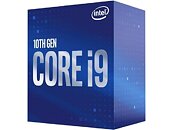
Intel's Apple-exclusive Core i9-10910 Geekbenched
Intel designed an Apple-exclusive Core i9-10910 10-core processor for its new-generation iMac, with an interesting set of specs. The chip has a base frequency of 3.60 GHz - much higher than the 2.90 GHz of the i9-10900 - but a lower max boost frequency of 5.00 GHz (against 5.20 GHz TVB max of the i9-10900). The TDP of the new chip is rumored to be higher, at 95 W, giving its boosting algorithm more breathing room. Leakbench, a twitter handle that tracks interesting submissions to the Geekbench online database, fished out one of the first Geekbench 5 submissions of the i9-10910.
The i9-10910 serves up 6.9% higher single-threaded performance than the i9-10900. It however, falls behind the i9-10900 in multi-threaded performance by 9.6%. These results as surprising. Normally, we'd expect the i9-10910 to have a lower single-threaded performance and higher multi-threaded performance. As its max boost frequency is lower, and the i9-10900 is able to run single-threaded workloads on its favored cores at frequencies of up to 5.20 GHz (as opposed to 5.00 GHz on the i9-10910). On the other hand, with a higher TDP (higher PL1), the i9-10910 has more power budget for its cores to sustain higher boost states, which should give it a slight edge over the i9-10900 in multi-threaded performance. The raison d'être of the i9-10910 appears to be in giving Apple a variation of the 10-core "Comet Lake" die that macOS can make the most of, as it probably lacks optimization for Turbo Boost Max 3.0 and Thermal Velocity Boost.
The i9-10910 serves up 6.9% higher single-threaded performance than the i9-10900. It however, falls behind the i9-10900 in multi-threaded performance by 9.6%. These results as surprising. Normally, we'd expect the i9-10910 to have a lower single-threaded performance and higher multi-threaded performance. As its max boost frequency is lower, and the i9-10900 is able to run single-threaded workloads on its favored cores at frequencies of up to 5.20 GHz (as opposed to 5.00 GHz on the i9-10910). On the other hand, with a higher TDP (higher PL1), the i9-10910 has more power budget for its cores to sustain higher boost states, which should give it a slight edge over the i9-10900 in multi-threaded performance. The raison d'être of the i9-10910 appears to be in giving Apple a variation of the 10-core "Comet Lake" die that macOS can make the most of, as it probably lacks optimization for Turbo Boost Max 3.0 and Thermal Velocity Boost.


